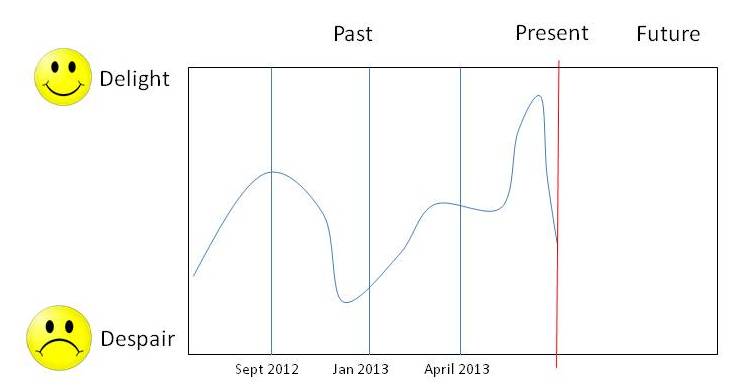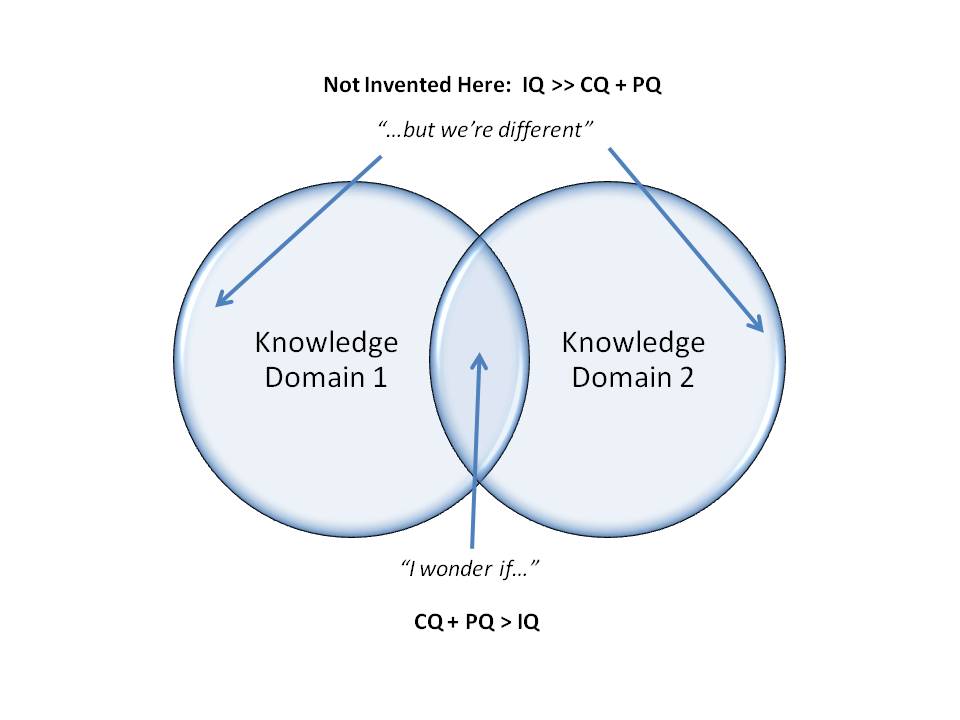So with particular thanks to Eric, Harald, Svetlana and Miguel who added some great ideas - here are ten different options for KM Strategy implementation.
1. Top Down, Big Bang.
This is the traditional "someone at the top has said this needs to happen" approach, usually accompanied by a cascade, a change initiative, communications and engagement plan, brown-bag presentations, training programmes, mugs and mouse mats. We've all seen these initiatives in action - and in some organisations they can be the only way to get people's attention. The challenge, of course is to find ways to keep people's attention - particularly when the board or senior sponsors have moved onto their next big bang. You might consider setting up a programme board with some of the senior players, which will keep them collectively on-the-hook for your programme. It's much more difficult for the whole group to shift their energy away than it is for a single sponsor to become distracted by the next big idea.
So it's the challenge of sustainability, which leads us neatly to the second approach - Top Down, Bottom Up.
2. Top Down, Bottom Up
This approach is a sophistication of the Big Bang approach, using the same level of visible senior support to send a clear message across the organisation. The critical difference is that there is a deliberate effort to harness the energy and passion of workers at the front line, and to involve them in the programme, perhaps as group of advisors or a community of practice. These people are key in helping to translate the messages from the top and set them in the right context locally. BP had a two-year programme with a team of 10 with a brief to define and demonstrate the value of KM. But it was KM Community of practice - around 200 enthusiasts who recognised the value that it brought to their day-to-day roles - this was the group who helped KM to be more sustainable. They were also an excellent source of anecdotes and credible stories of where KM had made a difference at the sharp-end.
3. Slipstream.
In most organisations, you can guarantee that there will be a number of organisational initiatives in flight at any one time. Rather than wait for a gap in the traffic which will never come, or to launch a competing campaign to capture the attention of an already saturated workforce, there is a third way! Slipstreaming is about working in partnership with other initiatives or "transformation projects" (don't you just love that phrase?), looking for ways in which you can feed of each others' momentum. The beauty of KM is that it's such a broad discipline that it is easy to find ways to complement and support other programmes and functions. I have seen KM effectively slipstream behind business improvement and Six Sigma projects; operational excellence, new project management methodologies, SharePoint deployments, acquisition integration activities, customer management and asset management initiatives, culture change movements and the roll-out of new corporate values. [You might question whether you can change culture with an initiative, or roll-out values - we'll leave that for a future post - but you get the idea...]
One thing to be wary of, which affects competitive cyclists and athletes who slipstream - is the danger of getting "boxed in". If you're slipstreaming the roll-out of SharePoint with a view to sharing a broader set of knowledge-sharing behaviours and methods, then watch out that the technology doesn't grab all the headlines and rob you of impact. It's always best to agree these things up-front as part of the partnership, rather than "pop out" unexpectedly and assume that you can push KM to the forefront!
4. Outside In.
This approach is a little higher risk, but does come with its own in-built parachute. Sometimes things just sound better when they are heard from the outside. People who would treat an internal newsletter or intranet article with a degree of scepticism will pay attention to the same story when it appears in a journal or arrives via their RSS feed – or when a friend of customer mentions that it just arrived in their RSS feed. It’s the power of outside-in. Geoff Parcell and I found that when we published the first edition of Learning to Fly in 2001, it gave reach, awareness and credibility to the KM programme way beyond anything we could have achieved ourselves. Rio Tinto experienced a similar unexpected impact when they published their video on Communities of Practice on YouTube. It just works, and it creates momentum inside the company to fill in any gaps between what is said externally and what happens internally.
And if you do over-reach? Well, all that publicity should help you to find a soft landing somewhere else!
5. Viral
This is a variant of the pilot approach and usually involves technology. BT experienced it with the launch of their BTPedia internal wiki back in 2007, Russian financial services giant Sberbank encountered it with the launch of their ideas management system in 2011, and the roll-out of many micro-blogging environments like Deloitte's Yammer have taken on a life of their own this year. With a viral approach, you need to be prepared for it to be messy - it's a case of let a thousand flowers bloom, pick the best ones and do the weeding and gardening later. However, it's hard to imagine "lessons learned", "knowledge retention" or the creation of knowledge products spreading like wildfire. You'll need to make the most of the extra momentum and have a plan up your sleeve to connect the parts of KM which spread virally with the other techniques and methods which require more effort to adopt.
6. Stealth
Sometimes labels get in the way.
Sometimes you have to find ways to build up your organization's capability to manage and share knowledge without them realising what your master plan actually is. You get smart at making small adjustments to processes, spotting political opportunities and allies, tweaking the configuration of information-sharing platforms and the wording of competency frameworks and values; encouraging networks and facilitating conversations which improve performance and learning. After a few years, you'll be able to look back and say to yourself "you know what, we're pretty good at managing and sharing knowledge. - but you probably won't get a plaudit or bonus - just the satisfaction of having helped to build a knowledge-friendly environment which is probably more sustainable than any managed programme would have achieved.
If you like the sound of that, and can live with the lack of recognition, then perhaps a career as an independent KM consultant awaits you!
7. Copycat
This is more of a tactic than an implementation strategy per se - but it's often successful to point to examples of successful KM from other organisations (competitors and customers are particular impactful) to create some "me too" or "me better" demand. Find a good example and invite them in to tell their story. Check whether your board members have non-executive directorships or recent prior experience of other companies. They might be good ones to pursue! Copycat can work well internally too, encouraging business units to out-do each other in successful knowledge sharing, but make sure that the measures you use to compare and celebrate don't create a new set of competing silos. ConocoPhillips' '4G' awards (Give, Grab, Gather, Guts) and Syngenta's TREE awards (Transfer, Reuse, Embed, Experience) both focus on giving and receiving - hence they compete to out-share each other - which has to be a good thing!
8. Pilot
A Pilot approach will often take a subset of KM methods and apply them locally - in contrast to the big bang, which usually takes KM as a whole and attempts to apply it globally. It's all about lighting a number of fires to see what spreads. A pilot enables you to try the aspects of KM most likely to make a difference quickly, to build credibility locally, and to learn from each implementation. That could mean launching a community of practice for one part of the organisation whilst closing the learning loop on major projects and working on knowledge retention for retiring experts. Criteria for a successful pilot?
capable of showing results (measurable value would be good) within 6 months;
strategic;
repeatable elsewhere;
close to the heart of any key sponsor or stakeholder, and
ideally a recognisable part of the organisation (not too esoteric) which will make their story easy to understand.
9. The Buffet Menu
The success of a buffet approach depends on a high level of demand for knowledge. Rather than investing effort in creating an appetite, or a willingness to experiment - this approach works with the demand already present, and provides an array of tools and techniques which the organisation chooses from at will, once their "palate" is sufficiently educated.
The International Olympic Committee is a great example of this. They set out a veritable smorgasbord of learning processes, observation visits, secondments, extranet platforms, access to experts, databases, distilled recommendations and lessons learned. A knowledge feast for a future organising committee, who enter the 7-year process with a tremendous appetite for knowledge. On a smaller scale (and let's face it, everything looks small compared to the Olympics!), management consultancies operate their KM programmes using the demand for knowledge which accompanies each new assignment.
Demand-led programmes are more likely to be sustainable - no need to persuade people to change their behaviour - adrenaline drives them to it!
10. Phoenix from the ashes
For a lot of organisations, KM is not a new idea. For many of them, there have been several historical big bangs, pilots and copycat initiatives. Talk with people about what has happened in the past and learn from it. Corporate KM started in the mid '90s, so you'll be looking for people with grey hair (working in KM does that to people). Sometimes just having these conversations can rekindle enthusiasm, tinged with nostalgia. Why didn't we make more of that? What did we lose momentum then? Perhaps now the timing is better? Perhaps now, with a new sponsor, or now that we've addressed that particular barrier? It is quite possible for KM to rise, phoenix-like from the ashes and fly higher than it did before.
So whether you're a viral copycat or a phoenix stealthily approaching a buffet from the outside in, here's ten options to consider, with a little help from the inaugural UN KMOL class of 2013.














